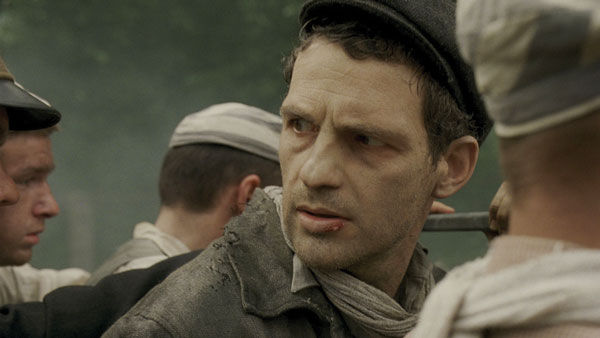‘Son of Saul’ is a powerful, difficult trip into Auschwitz
Published January 27, 2016
“Son of Saul” is a powerful, cinematically brilliant drama that takes viewers into a first-person experience of the Auschwitz concentration camp. It is an impressive film debut for Hungarian director Laszlo Nemes, a descendant of Shoah survivors. The film won the 2015 Cannes Grand Prix, a Golden Globe and is the leading contender for the Best Foreign Language Oscar.
Still, due to its unblinking realism, this is not a film for everyone.
“Son of Saul” takes a different approach from films like “Schindler’s List” or “The Pianist.” It is neither a survivor’s story nor a recap of the big picture of the Shoah. It is a film made with different intentions, aiming to accurately depict the Nazis’ brutality through details of the mechanics of their death machine, based on eyewitness accounts.
The murderous work of the camps is shown through the eyes of one person very close to that factorylike horror. This is a hard film to watch, even though it avoids graphic depictions of what happens in the gas chambers.
Géza Röhrig plays Saul Auslander, a Jewish Hungarian man in Auschwitz in 1944. Saul is part of the Sonderkommandos, the work detail assigned the awful tasks of both calmly leading people into the gas chambers and clearing out the corpses afterward.
Saul becomes convinced that a certain boy he finds in the death chamber is his son. So he devises a plan to steal the body to prevent it from being burned, find a rabbi to say Kaddish and give the boy a proper burial. He tries to carry out this secret task as the other Sonderkommandos are preparing for a revolt, a real event that was the only armed uprising to occur in Auschwitz.
The Sonnderkommandos were isolated from the other prisoners in the camp. Due to their work, they were given a degree of freedom to move about; hence, Saul moves around the camp while other prisoners cannot. He wears a jacket with a red X on the back, making it easier to track him in a crowd, but it is also a historical detail, something the SS did to make it easier to shoot anyone attempting to escape.
Saul’s quest takes him from the death chambers to the autopsy rooms and across the camp as he searches the other Sonderkommando groups and new arrivals for a rabbi. We hear voices speaking in multiple languages, but they are snatches of passing conversation unless Saul is focused on it. What the audience knows, sees or hears is limited to what Saul knows, sees or hears.
Because the film is point-of-view, it is immersive and, therefore, particularly terrifying.
The filmmakers intended it to be the experience of one man caught in that hell. The director was inspired to make the film after reading “Voices From Beneath the Ashes,” eyewitness accounts written by former members of the Sonderkommando teams at Auschwitz.
Röhrig is brilliant as Saul, although he is not a professional actor. A Hungarian-born writer, Rohrig graduated from the Jewish Theological Seminary of New York. The director cast him in part for his distinctive appearance, but Nemes also wanted someone with a theological grounding for the role.
Saul’s quest is one that is deeply human, ancient and sacred: the final rites accorded the human dead, in stark contrast to the inhumane, mechanical actions of the Nazi mass murderers. Yet, what Saul is doing often seems disconnected from the reality around him, even delusional, actions more symbolic and even at odds with what the other prisoners are doing to rebel or resist.
The film is visually striking, plunging us into Saul’s worldview without preamble. Cinematographer Mátyás Erdély shot on 35mm film rather than digital, which gives the film a stronger emotional feel. The camera follows Saul through the events of two days, often peering over his shoulder, as if we are carried on his back. Occasionally, the camera turns on Saul’s face, so we see his reaction to what he sees or what is said. Always, the camera is very close, and we see a very restricted view of everything, using shallow-focus photography that blurs anything in the background.
All that we see and much of what happens as Saul moves through the camp is historically based, although his character is fictional. Events such as the revolt and the attempt to photograph the Nazis’ actions to create a record were real.
“Son of Saul” is a remarkable, artistically worthy film depicting the brutality of the Shoah, unlike any other film about the Holocaust. Nevertheless, it is not a film everyone will want to see.














